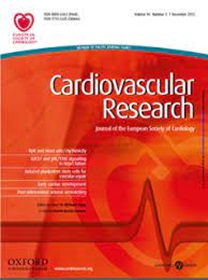铁、脂质过氧化和铁下垂在动脉粥样硬化中起致病作用
IF 10.2
1区 医学
Q1 CARDIAC & CARDIOVASCULAR SYSTEMS
引用次数: 0
摘要
脂质氧化、细胞过度死亡和铁沉积是人类动脉粥样硬化斑块的显著特征。虽然广泛的研究已经确定了脂质氧化和细胞凋亡在动脉粥样硬化发展中的有害作用,但铁在动脉粥样硬化发生中的作用尚未完全清楚。随着铁依赖性细胞死亡形式铁下垂的出现,铁、铁下垂和动脉粥样硬化之间的复杂相互作用引起了新的关注。从机制上讲,铁下垂是由铁介导的脂质过氧化物的致命积累引起的。新兴研究强调铁下垂是动脉粥样硬化恶化的一个因素。在此,我们回顾了动脉粥样硬化背景下的氧化损伤和铁超载可能促进斑块内铁下垂的证据。此外,我们总结了最近在动脉粥样硬化不同阶段的各种斑块细胞类型(如内皮细胞、巨噬细胞、树突状细胞、T细胞和血管平滑肌细胞)中脂质过氧化的发现,从而可能导致铁凋亡。了解这些过程如何影响动脉粥样硬化斑块的进展,可以针对每个细胞群的阶段依赖性铁下垂,并可以为开发细胞类型特异性干预策略提供理论依据,以有效减轻动脉粥样硬化性铁下垂。本文章由计算机程序翻译,如有差异,请以英文原文为准。
Iron, lipid peroxidation and ferroptosis play pathogenic roles in atherosclerosis
Oxidation of lipids, excessive cell death and iron deposition are prominent features of human atherosclerotic plaques. While extensive research has established the detrimental roles of lipid oxidation and apoptosis in atherosclerosis development, the involvement of iron in atherogenesis is not yet fully understood. With the emergence of an iron-dependent form of cell death termed ferroptosis, new attention has been brought to the complex interplay among iron, ferroptosis and atherosclerosis. Mechanistically, ferroptosis is caused by the lethal accumulation of iron-mediated lipid peroxides. Emerging studies have underscored ferroptosis as a contributor to worsened atherosclerosis. Herein, we review the evidence that oxidative damage and iron overload in the context of atherosclerosis may promote ferroptosis within plaques. Furthermore, we summarize recent findings of lipid peroxidation, thereby potentially ferroptosis, in various plaque cell types—such as endothelial cells, macrophages, dendritic cells, T cells, and vascular smooth muscle cells—across different stages of atherosclerosis. Understanding how these processes influence atherosclerotic plaque progression may permit targeting stage-dependent ferroptosis in each cell population and could provide a rationale for developing cell type-specific intervention strategies to mitigate atherogenic ferroptosis effectively.
求助全文
通过发布文献求助,成功后即可免费获取论文全文。
去求助
来源期刊

Cardiovascular Research
医学-心血管系统
CiteScore
21.50
自引率
3.70%
发文量
547
审稿时长
1 months
期刊介绍:
Cardiovascular Research
Journal Overview:
International journal of the European Society of Cardiology
Focuses on basic and translational research in cardiology and cardiovascular biology
Aims to enhance insight into cardiovascular disease mechanisms and innovation prospects
Submission Criteria:
Welcomes papers covering molecular, sub-cellular, cellular, organ, and organism levels
Accepts clinical proof-of-concept and translational studies
Manuscripts expected to provide significant contribution to cardiovascular biology and diseases
 求助内容:
求助内容: 应助结果提醒方式:
应助结果提醒方式:


